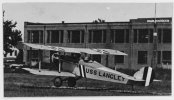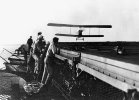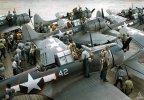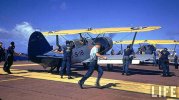I believe the third a/c in the pic is part of the Frasca collection of planes. It was used for flight deck scenes in the first "Midway" movie, which were filmed on the deck of the USS Lexington, tied up in port at NAS Pensacola. While I was going to college in the early '70's, I worked part time for Rudy Frasca, owner of Frasca Aviation, now Frasca International. (https://www.frasca.com/) I was one of 3 college kids employed by him then, with only 13 total employees at that time. Now it's a large company with it's own airport and large manufacturing facility. I performed some maintenance on that particular FM-2. (https://www.rodbearden.com/Av09/Rudy Frasca/Grumman FM2 Wildcat N6290C 10.html)
-
Please take a moment and update your account profile. If you have an updated account profile with basic information on why you are on Air Warriors it will help other people respond to your posts. How do you update your profile you ask?
Go here:
Edit Account Details and Profile
You are using an out of date browser. It may not display this or other websites correctly.
You should upgrade or use an alternative browser.
You should upgrade or use an alternative browser.
The Great, Constantly Changing Picture Gallery, Troisième partie: la vengeance!
- Thread starter SynixMan
- Start date
VMO4
Well-Known Member
My father was in VC-8 on the Guadalcanal CVE-60, then finished out the war years at St Simons Isle , Georgia as a det of about 10 FM-2s, whose daily job was to fly patterns out over the Atlantic so the new radar intercept guys out of Mayport could practice radar intercepts, ...in what I consider one of the great Naval Aviation Assignments of all time.
EAA picture from Oshkosh 25View attachment 43827

206K views · 6.1K reactions | The Heritage STOL Competition (Short Takeoff and Landing) 2025 is this Saturday, Sept 6th! Click the event link - or visit our website to get your tickets to this exciting competition! Amongst the top competitors from
The Heritage STOL Competition (Short Takeoff and Landing) 2025 is this Saturday, Sept 6th! Click the event link - or visit our website to get your tickets to this exciting competition! Amongst the...
 www.facebook.com
www.facebook.com
GroundPounder
Well-Known Member
I've seen contests with bush planes, but never with warbirds. That would be good to see in person.
206K views · 6.1K reactions | The Heritage STOL Competition (Short Takeoff and Landing) 2025 is this Saturday, Sept 6th! Click the event link - or visit our website to get your tickets to this exciting competition! Amongst the top competitors from
The Heritage STOL Competition (Short Takeoff and Landing) 2025 is this Saturday, Sept 6th! Click the event link - or visit our website to get your tickets to this exciting competition! Amongst the...www.facebook.com
Works better with wind over the deck!I've seen contests with bush planes, but never with warbirds. That would be good to see in person.
From the quickly painted red outlines on the rondel you can tell this photo was taken in 1943…probably early summer, Solomon’s area.
And so it began...
In 1922, the conversion of the collier USS Jupiter to the aircraft carrier USS Langley (CV 1) was complete and it was time to try out this marriage of ship and aircraft.
The first flight ops took place in October of 1922. LT Griffin made the first takeoff on 17 October in a Vought VE-7. Nine days later, LCDR De Chevalier made the first arrested landing in an Aeromarine 39-B.


In 1922, the conversion of the collier USS Jupiter to the aircraft carrier USS Langley (CV 1) was complete and it was time to try out this marriage of ship and aircraft.
The first flight ops took place in October of 1922. LT Griffin made the first takeoff on 17 October in a Vought VE-7. Nine days later, LCDR De Chevalier made the first arrested landing in an Aeromarine 39-B.





